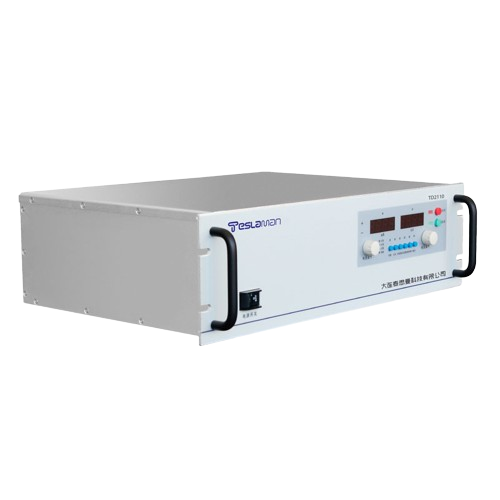Research on Pulse Frequency Optimization of High Voltage Power Supplies for Coating Applications
1. Mechanism of Pulse Frequency on Coating Quality
In pulsed magnetron sputtering (PMS), the pulse frequency (typically 1-350 kHz) of high-voltage power supplies directly affects plasma density, target ionization rate, and film stress distribution. Experiments show that frequencies below 50 kHz result in insufficient ion kinetic energy, increasing film porosity to over 8%, while frequencies exceeding 250 kHz exacerbate electron oscillation effects, causing abnormal target heating and lattice distortion risks. Particle simulations reveal that matching pulse rise times (<500 ns) with plasma relaxation times in the 100-200 kHz range can improve film hardness by 20%-30%.
2. Key Technical Strategies for Pulse Frequency Optimization
1. Adaptive Resonant Topology Design
A hybrid LLC resonant-Marx generator structure enables programmable frequency output with ±0.01% accuracy across 10-300 kV. The high-frequency characteristics of SiC MOSFET modules (switching up to 2 MHz) reduce energy losses to 18% of traditional solutions while minimizing electromagnetic interference in sputtering chambers. Measured data show frequency drift remains within ±5 ppm during 8-hour continuous operation.
2. Dynamic Duty Cycle Compensation Algorithm
A closed-loop system using plasma spectrum feedback dynamically adjusts pulse duty cycles (10%-90%) via high-speed ADC (1 GS/s sampling rate) analyzing Ar+ 488 nm spectral intensity. This technology improves film thickness uniformity from ±5% to ±1.2%, particularly for curved substrates.
3. Multi-Physics Coupling Simulation Model
A multi-scale electromagnetic-thermal-plasma model optimizes pulse waveform parameters through finite element analysis. For DLC coatings, trapezoidal pulses (150 kHz, 60% duty cycle) reduce residual stress from 3.5 GPa to 1.8 GPa, while substrate bias synergy enhances adhesion to over 70 N.
3. Breakthroughs in Industrial Applications
1. Multi-Chamber Frequency Synchronization
In roll-to-roll (R2R) coating lines, fiber-optic timing and distributed FPGA systems achieve ±2 ns phase synchronization across 32 sputtering sources, reducing surface resistance variation in 300 mm-wide films from 8% to 0.5%.
2. Intelligent Fault Prediction System
Acoustic emission sensors and vibration spectrum analysis monitor abnormal target discharges. When arc energy exceeds 50 mJ, the system cuts pulses within 10 μs and activates reverse arc suppression, lowering target consumption from 0.8%/h to 0.15%/h.
4. Future Technological Trends
1. Ultra-High Frequency Pulse Modulation
GaN HEMT-based topologies extend pulse frequencies to MHz levels. Combined with 3D magnetic core designs, plasma ionization rates exceed 95%. Preliminary tests show 1.2 MHz pulses improve TiO2 film photocatalytic activity by 4×.
2. Digital Twin-Driven Process Optimization
A virtual coating process twin uses machine learning to predict film properties under varying frequency-pressure-temperature conditions, reducing development cycles by 60% and material waste by 45%.




















